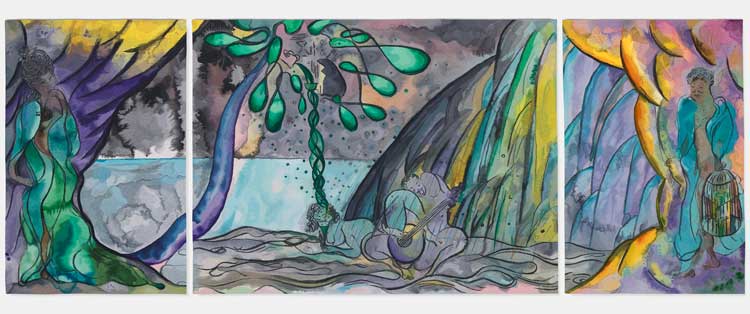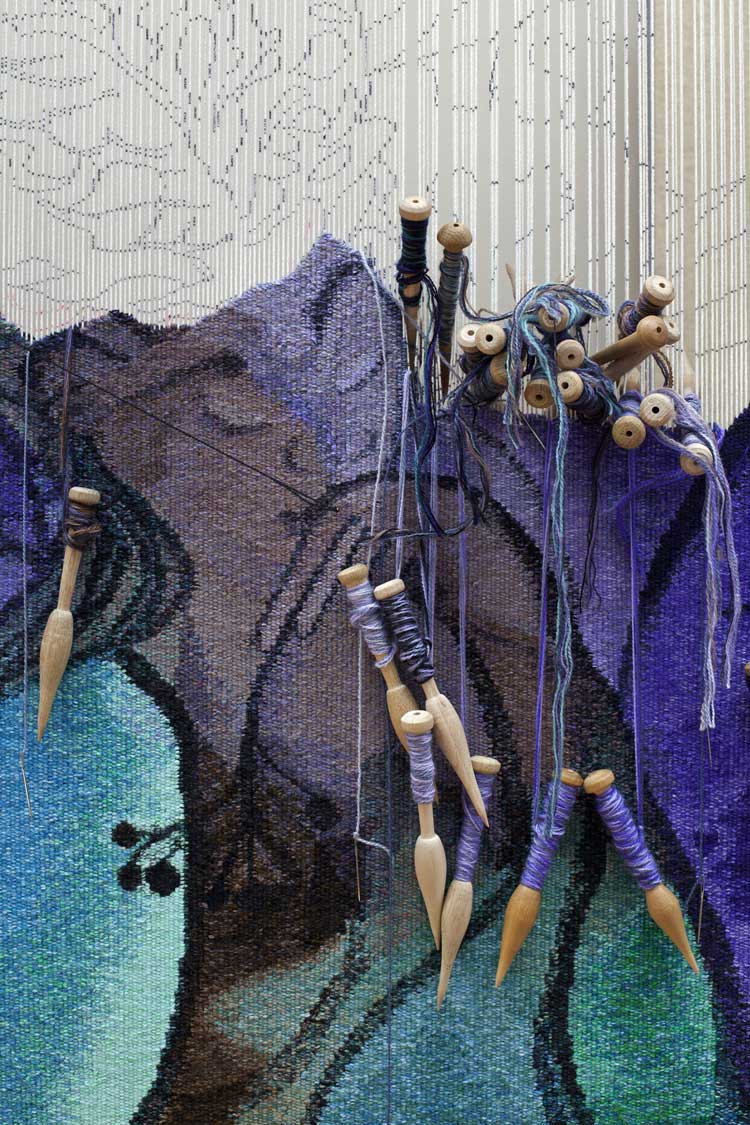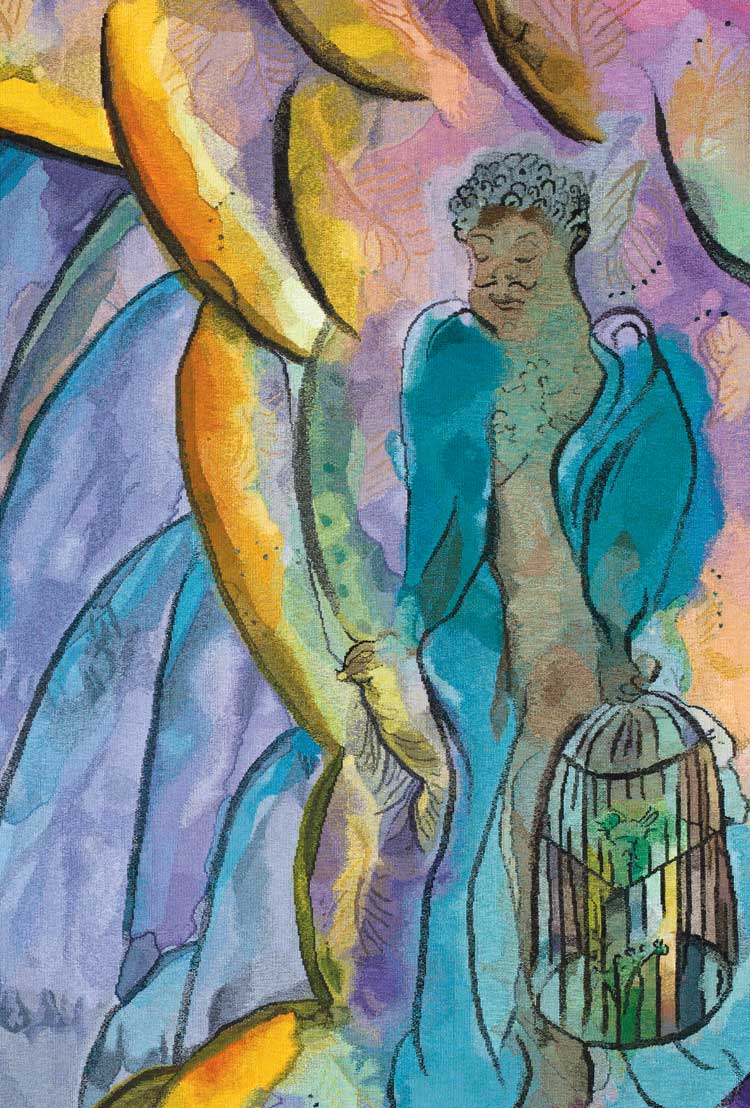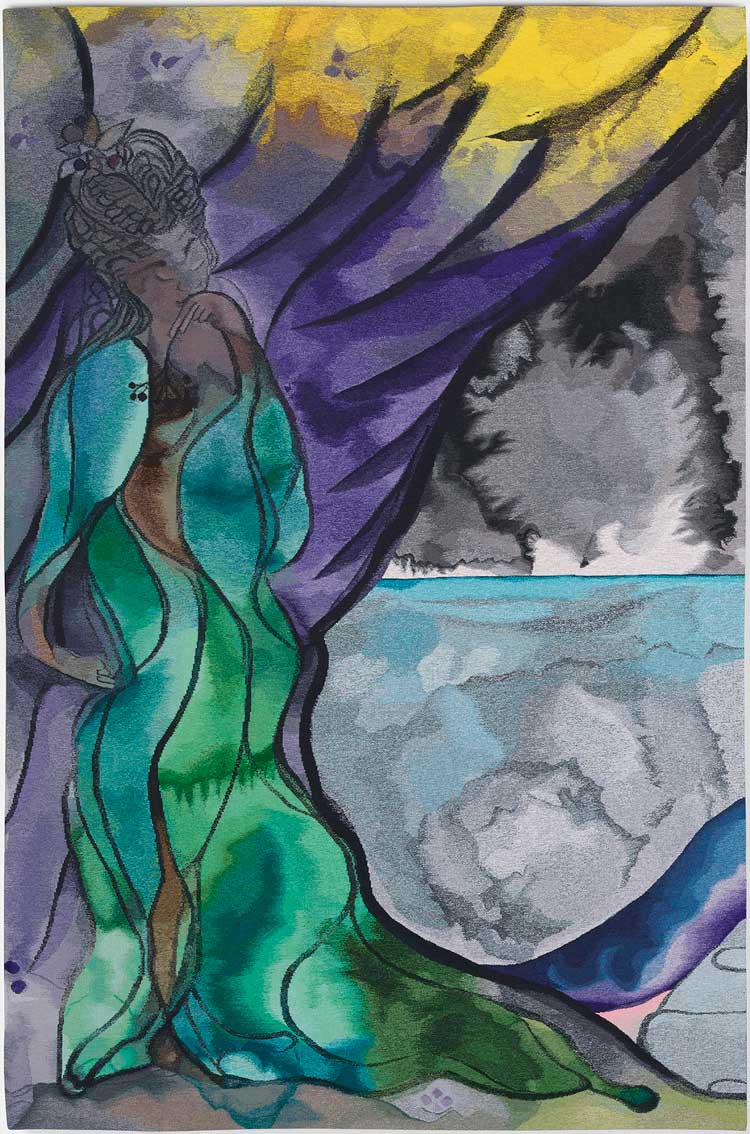.jpg)
Installation view, Chris Ofili: The Caged Bird's Song, Dovecot Studios, Edinburgh, 2024 featuring The Caged Bird's Song tapestry triptych by Chris Ofili, 2014–2017. © The artist. Courtesy the artist and Victoria Miro, The Clothworkers' Company and Dovecot Tapestry Studio, Edinburgh. Photo: Phil Wilkinson.
Dovecot Studios, Edinburgh
28 June – 5 October 2024
by BETH WILLIAMSON
How do you weave water and watercolour? That was the challenge that Chris Ofili (b1968) set the team of weavers at Edinburgh’s Dovecot Studios with his design for the triptych tapestry The Caged Bird’s Song (2014-2017). In fact, these challenges were ones the weavers had faced many times before, so they weren’t tested by the material articulation in the way that Ofili, perhaps, thought they would be. Still, as Dovecot’s head of studio and a master weaver, Naomi Robertson, muses in the audio conversation available to visitors in the exhibition: “Neither of those were new challenges to us, but it is always a challenge, trying to capture that translucency of watercolour into wool and cotton is quite difficult”.1 The fluidity of colours was a matter from which both parties in this collaboration learned. The unusual colour combinations in Ofili’s original watercolour painting brought their own challenges as weavers worked to create the same fluidity, vibrancy and sense of spontaneity in a medium that requires meticulous planning, testing and fixity. Meanwhile, Ofili was surprised by the colours combined in wool or cotton to achieve what was required by his visually startling design. As he explained: “One of the things I hadn’t understood was this weaving together of different colours to get a feeling of a colour, the vibration of a colour – its orchestration, really.”2

Chris Ofili, The Caged Bird's Song, 2014–17. Triptych, wool, cotton and viscose, left and right panels each 280 x 184 cm; centre panel 280 x 372 cm. © Chris Ofili. Courtesy the artist and Victoria Miro, The Clothworkers' Company and Dovecot Tapestry Studio Edinburgh. Photo: Stephen White.
The project began in 2014 when the Dovecot, Britain’s oldest practising tapestry studio, was commissioned by the Clothworkers’ Company to realise Ofili’s design (Ofili was first approached by the Clothworkers’ late in 2013).3 Following the finished tapestry’s exhibition at the National Gallery in London in 2017 and later that year at Clothworkers’ Hall, its permanent home, the tapestry has come full circle, returning to Dovecot Studios for the duration of this exhibition, which is a masterclass in how to design an exhibition around a single artwork. The back story of its conception and making is not only fascinating but brings with it real insight into a collaborative process that rarely gets the kind of attention it perhaps should. While multiple weavers worked carefully to retain the hand of the artist, they also worked to erase the differences between themselves, so any weaver could pick up the work of another. The complexity of the weaving process is not only the practical matter of manipulating threads but the weavers must work on just a small section at a time while keeping in mind the overall design of three panels that together extend to 7.7 metres (25ft) in length and 2.4 metres (8ft) in height. Over a period of almost three years, the weavers translated Ofili’s watercolour design on to the loom, “interpreting, replicating, and magnifying each and every colour and nuance with great skill and artistry”.4
The exhibition provides a rich context for Ofili’s tapestry, some might say a little too much context. It is wonderful to see and hear about the collaboration between artist and weaver, the making process at Dovecot, and the various issues that the weavers had to address. However, a fairly detailed account of the London livery companies, of which the Clothworkers’ Company is one, feels a little heavy going, especially as it is the first thing you encounter in this show. Still, the place of this London livery company at the very heart of the commission perhaps explains that approach.
It is helpful for visitors to understand something of the history of the Dovecot itself and the process of becoming a weaver. The scope and extent of the training that weavers undergo is phenomenal, with a period of up to 10 years needed to become a master weaver. Apart from weaving techniques, apprentices learn about design practices and artistic collaborations. The three years of training required to become a junior weaver, and the additional experience to achieve master weaver status, means that endangered weaving skills are safeguarded and developed. Often weavers are working with artists who have never worked in the medium before.

Chris Ofili, The Caged Bird's Song, 2014–2017 at Dovecot Tapestry Studio, Edinburgh. Courtesy the artist and Victoria Miro, The Clothworkers' Company and Dovecot Tapestry Studio, Edinburgh. Photo: Gautier Deblonde.
Just as watercolour was Ofili’s chosen medium for his design, water is key to the iconography of the imagery in The Caged Bird’s Song. The central panel evokes an Arcadian vision as two voluptuous nudes sit by water. The blues, purples and green in this section of the design mark out a male figure serenading a reclining female with guitar music. A waterfall cascades in torrents and beyond it a calm sea forms a peaceful backdrop to the couple’s self-absorption. Above them a sinister figure appears in the clouds and pours liquid into the woman’s mouth, creating a rising screen of bubbles and gesturing to something magical and transformative.

Chris Ofili, The Caged Bird's Song, 2014–17. Triptych (right panel), wool, cotton and viscose, 280 x 184 cm. © Chris Ofili. Courtesy the artist and Victoria Miro, The Clothworkers' Company and Dovecot Tapestry Studio Edinburgh. Photo: Gautier Deblonde.
In the panels that flank either side, a single figure veiled by curtains appears in each, a nod to Titian’s Diana and Actaeon, suggests the curator and writer Minna Moore Ede. On the right-hand panel, a mustachioed man with abundant chest hair carries the titular caged bird in one hand and a feathery branch in the other. The plant is known as “crab-eye grass” in Trinidad – Ofili’s home since 2005 – where it is believed that its peppery seed, when fed to songbirds, will make them sing more sweetly. Ofili says: “You see men carrying these birds everywhere, in construction sites, even sat in taxis on the way to work.”5 This relates to the title of the tapestry, which also echoes the title of the first volume of Maya Angelou’s autobiography I Know Why the Caged Bird Sings, published in 1969.

Chris Ofili, The Caged Bird's Song, 2014–17. Triptych (left panel), wool, cotton and viscose, 280 x 184 cm. © Chris Ofili. Courtesy the artist and Victoria Miro, The Clothworkers' Company and Dovecot Tapestry Studio Edinburgh. Photo: Stephen White.
On the left-hand panel, a woman with coiffured hair is resplendent in a flowing gown in blues and greens. In Ofili’s watercolour painting, both this and the right-hand panel were painted before the central one, as if the two lone figures are narrators of the central story. What isn’t clear, is whether they are onlookers to the central scene, or the same two characters looking at themselves and imagining a past or future life. Ofili’s layering of imagery and ideas, explored in his water colour design have been expertly translated into this luscious tapestry, accessible in Scotland’s capital city only temporarily. In the making of this tapestry, Ofili’s own geographic connections were never overlooked. As Robertson observed: “We were weaving Trinidad, to some extent, in Scotland.”6 Visit The Caged Bird’s Song now for a little bit of Trinidad in Edinburgh.
This exhibition also forms part of Edinburgh Art Festival which runs from August 9 to 25, 2024.
References
1. Naomi Robertson in Dovecot Weavers in Conversation – Weaving the Caged Bird’s Song. Audio recording and transcription available in the exhibition space.
2. Chris Ofili quoted in exhibition wall text.
3. Chris Ofili: Weaving Magic by Minna Moore Ede, published by the National Gallery, London, 2017, page 7.
4. The Clothworkers’ Company website.
5. Ofili quoted in Chris Ofili: Weaving Magic, op cit, page 20.
6. Naomi Robertson quoted in exhibition wall text.